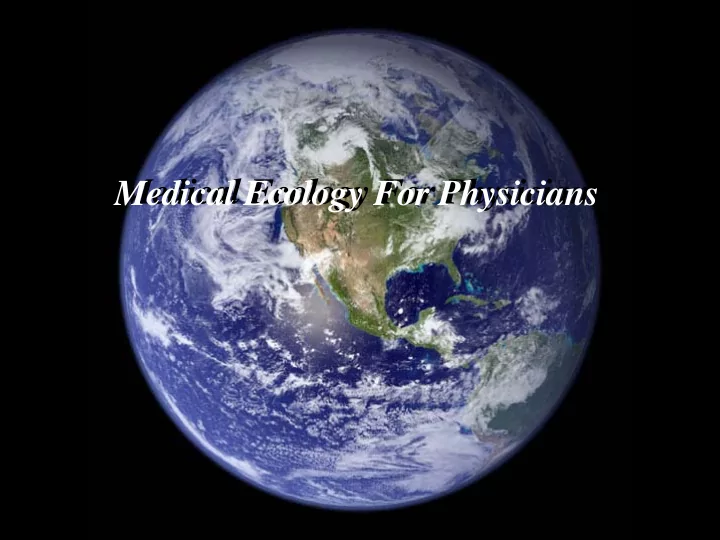

Medical Ecology For Physicians Medical Ecology For Physicians
Beyond the Fire-Hazard Mentality of Medicine: The Ecology of Infectious Diseases Jane Bradbury Published November 17, 2003. http://biology.plosjournals.org/plosonline/?request=get-document&doi=10.1371/journal.pbio.0000022
Environment and Infectious Diseases SARS West Nile Virus Cholera
SARS 8,500 cases in 2003 Mortality rate: 15% Route of transmission: unknown (possibly fecal-oral; probably not droplet) Source of original outbreak: unknown
SARS in Health Care Workers
Length of Time of Exposure to Patients with SARS and Development of SARS in Healthcare workers
Why the WHO Influenza Surveillance System Missed the SARS outbreak:
China to Kill 10,000 Civet Cats in Effort to Eradicate SARS
Rat May Be Source of Vector in SARS Outbreak Dr. Stephen K. C. Ng, of Columbia University School of Public Health, New York, presents this hypothesis in this weeks' issue of The Lancet. The SARS outbreak involved 321 residents of Amoy Gardens in over 150 apartments located both upwind and downwind of the first person to be infected (index patient) in an area encompassing thousands of square meters and rising over 100 meters into the air. Ng comments that other theories, such as contaminated sewage droplets and fecal-oral contact through contaminated surfaces, cannot account for the dose, timing, and distribution of this outbreak.
A Change In WHO Surveillance Strategy "We must remain vigilant," said Henk Bekedam, the senior World Health Organization official in China. "We cannot know for certain whether SARS will return again." That may depend in part on the roof rats of Hong Kong.
This Just In: China: Urban Rats Test Positive for SARS in Guangzhou -------------------------------------------------- Urban rats may prove to be the source of infection for the new SARS case reported in December 2003 from Guangzhou, capital of Guangdong Province. The China Daily reports that laboratory tests have determined that rats caught in the SARS victim's apartment were carrying the SARS virus. Local media in Guangzhou had reported the patient had been trapping rats that had invaded his apartment before he showed any SARS symptoms; the patient had said that he had no known contact with the civet cat species identified publicly by the Chinese government as the probable source or reservoir for the disease. --
WNV West Nile Virus Culex pipiens
WNV 2001
WNV 2002
2002 Total Infections: 623,400 Total Cases: 4,156 Total Deaths: 284
WNV 2003
2003 Total Infections: 1, 678,600 Total Cases: 8,393 Total Deaths: 184
Why The Rapid Spread West?
Prevailing Winds Are From West To East
All Major US Highways Run East-West And North South
Ecology of West Nile Virus Epidemics Begin During : Chronic Drought High Summer Temperatures
Epidemics Spread 1-2 Weeks After The Drought Is Broken
The Epidemic Is Over Within 3-5 Weeks After The Drought Is Broken
Countries In Which West Nile Is Endemic*: Israel Southern Egypt South Africa * All have major deserts
WNV 2003
Nebraska - 1831 cases Colorado - 2477 cases South Dakota - 1013 cases
Cholera
V. cholerae is often found attached to the planktonic organisms
February 3 , 2 0 0 0 El Niño I ncreases Diarrheal Disease I ncidence by 2 0 0 Percent The El Niño phenomenon--the warming of the equatorial Pacific ocean that occurs every two to seven years--has been linked to outbreaks of dengue, malaria, and cholera. Now, researchers from the Johns Hopkins School of Public Health, A.B. Prisma, and the Instituto Nacional de Salud in Lima, Peru, have found that the 1997-1998 El Niño season increased hospitalizations for diarrheal disease by 200 percent, according to a study published in the February 5th issue of The Lancet . The results are cause for concern, said the researchers, since diarrhea already causes one billion episodes and three million deaths annually in children under five worldwide.
Distribution Of Estuaries
Trophic Relationships Of The Mangrove Estuary From: E. Odum Fundamentals Of Ecology
New Cholera Outbreaks Frequently Occur In Communities Adjacent To Estuaries. WHY?
Because Vibrio cholerae and its relatives are marine microbes, fully integrated into their respective food webs. Environmental Conditions Favoring Growth Of Vibrio: 1. Low salt 2. High Nutrient Load Marine copepod with 3. 20 O C Vibrio cholerae Phytoplankton Bloom attached to egg cases. 4. Triggers phytoplankton bloom 5. Followed by zooplankton bloom 6. Followed by a cholera outbreak
Monsoons 1. lower the salinity of the estuary 2. bring nutrients to the estuary 3. raise the ambient water temperature of the estuary
In the end, understanding the ecology of infectious diseases will allow for the application of long-term control measures.
The End The End
Recommend
More recommend